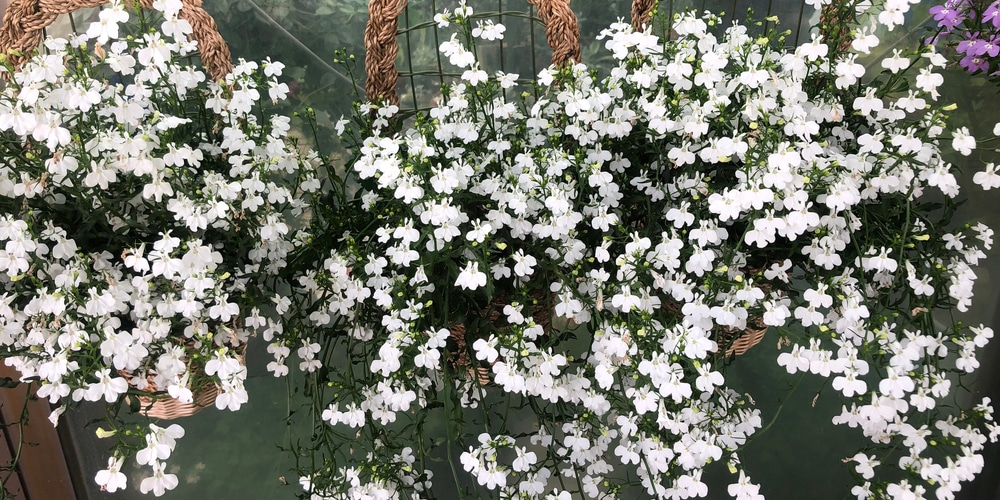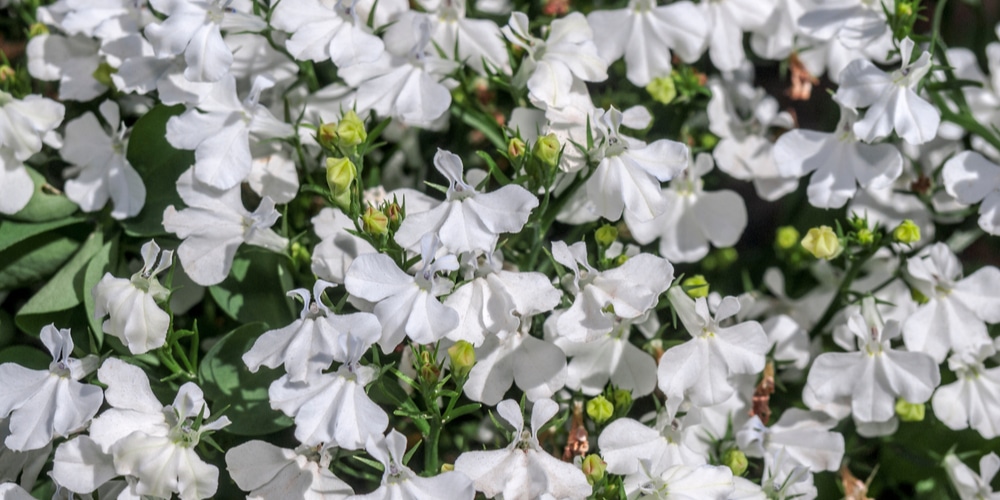The Hot Snow White Lobelia grows about 12 inches tall with a spread of 8 inches. While it’s not a true annual, the Hot Snow White Lobelia is a fast-growing plant that does best in full sun to partial shade. Let’s look at growing and caring for a hot snow white lobelia plant!
| Scientific Name | Lobelia erinus |
| Plant Type | Perennial |
| Sun Requirements | Full Sun to Partial Shade |
| USDA Hardiness Zones | 10 to 11 |
| Soil PH Range | Slightly acidic, neutral and slightly alkaline soil |
| Soil Type | Evenly moist, and well-drained water |
| Water Needs | High |
What you Need to Know About Hot Snow White Lobelia
Lobelia is a genus of more than 370 perennials, annuals, and even aquatics. Native to temperate and tropical areas globally grow in North, Central, and South America.
The plant is quite adaptable, but it prefers to grow in average to wet conditions and tolerate some standing water. While the soil pH is not particular, the Hot Snow White Lobelia grows best in rich soils. It’s even tolerant of urban pollution.
As a fine choice for the garden, it’s covered in stunning white flowers at the end of the stems from mid-spring to fall. These flowers are excellent for cutting. It has pointy leaves that remain green throughout the season.
The Hot Snow White Lobelia is a herbaceous annual with a medium texture that blends into the garden. But you can always grow it together with finer and coarser plants.
As a low-maintenance plant, it’s a good choice for attracting hummingbirds and butterflies. However, it’s an interspecific hybrid. This means parts of the plant are toxic to humans and animals. When planting, it’s essential to exercise care, especially around children and pets.
The Hot Snow White Lobelia contains lobeline, a volatile liquid alkaloid with a pungent and tobacco-like odor. This liquid is hazardous if ingested and irritates the nostrils.
How to Care for Hot Snow White Lobelia
Here’s everything you need to know about growing and caring for a thriving Hot Snow White Lobelia. Following these tips can help keep your lobelia blooming all summer long!
Light
The Hot Snow White Lobelia does best in full sun to partial shade. Thanks to its superior heat resistance qualities, the plant will continue to grow in both full sun and partial shade.
Out of strong direct sunshine or a lightly shaded position will ensure the plant keeps flowering and blooming for a long time. However, they need good, fertile, and moist soils that do not dry out, especially in summer.
You can sow lobelia seeds directly indoors. Start indoors about 10 to 12 weeks before the last frost in your area. After all danger of frost has passed, then you can sow directly into the moist soil outdoors.
Water and Soil Needs
To ensure your Hot Snow White Lobelia thrives and blooms, water them regularly. Keep the soil lightly and evenly moist. We recommend that you water the plants twice weekly. Daily watering is also recommended but only for potted plants.
The Hot Snow White Lobelia needs well-drained soil. It should be slightly moist and humus-rich with a pH of 6 to 7.5. As a fine choice for the garden, it’s a good selection for planting in containers and outdoor pots.
In fact, it’s often used as a filler in the container combination. If growing the Lobelia in outdoor containers and baskets, they will require more frequent watering than they would in the garden or yard.
Temperature Requirements
A temperature of 70 degrees F is ideal. The plants are low maintenance and do not require deadheading. Hardy in USDA zones 9-11, the Lobelia erinus is compact and popular.
Fertilizer
For your Hot Snow While Lobelia to bloom, work plenty of organic matter and compost into the soil. Do this before planting the seedlings or cuttings. We recommend that you fertilize twice a month using a water-soluble liquid fertilizer. Find a liquid fertilizer high in phosphorus.
Phosphorus is vital to plant growth. Found in every living plant cell, it helps in photosynthesis and nutrient movement within the plant. The mineral also helps in the transformation of starches and sugars and energy transfer.
Common Diseases
Pests and fungi can be responsible for browning. For example, rust is a common external fungus that usually starts on healthy tissues. Once affected, the fungus covers the plants in brown, orange, or dark-colored spores. The good news is you can treat the fungus.
Simply, treat your plants with neem oil sprays. It’s essential to act quickly to reverse the progression of the disease. To prevent future infections, allow your Hot Snow White Lobelia more room to breathe. Good air circulation prevents fungal problems.
The Hot Snow White Lobelia is susceptible to a red spider infestation. This causes the leaves to change color and fall. The best approach is prevention. To do so, mist the plants with cold water. This will keep red spider mites from attacking your plants. For a great effect, we recommend adding a few drops of organic Neem oil insecticide to the water.
Propagation
Here are the steps involved in properly propagating Hot Snow White Lobelia.
1. By Seed
Plant your Hot Snow White Lobelia seeds indoors early in the spring. Germination takes 14 days at 70 degrees F. The lobelia seeds can germinate at lower temperatures. However, it will take longer than the 14 days.
If sowing indoors, allow the seedlings to mature enough before transplanting outdoors. This should last a couple of months.
Related Article: How to Grow Lobelia From Seed?
2. By Cuttings
You can grow cuttings from a lobelia plant you’re especially fond of. If the parent plant is outdoors, find a protected spot indoors and relocate it. Do this early in the autumn. Ensure the parent plant continues to receive lots of sunlight and watering, especially through the winter.
When February comes, move the seedlings to a warmer position. Continue watering the seedlings, and when new growth appears, take cuttings and plant them in small pots filled with pure sand or sandy soil. Within a short time, roots should develop. When this happens, move your cuttings to permanent containers with organic-rich soil.
Related:

